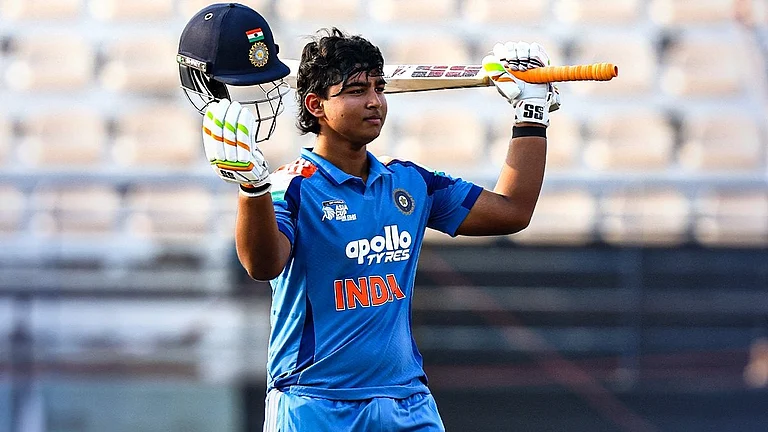On the eve of love and literature, I woke up to the dawn of more than a century ago, in a quaint village of the then Punjab. A matriarch of words, she goes on to become the recipient of Sahitya Akademi’ ‘Bharatiya Jnanpith,’ and ‘Padma Vibhushan’ and a household name in Akhand Hindostan (undivided India). Yes, I speak of Amrita Pritam.
Amrita Pritam’s words, as opposed to the usual journey of a reader discovering a writer, will find you when it’s your time to meet with yourself, from within. My story of how I met her (metaphorically, of course) is also one such day, I cannot forget. One college summer vacation at Nani House, I was helping Nani Maa clean her cupboards when I stumbled upon her journal. Now, my Nani is a passionate collector of artwork. On presenting her my proud findings, she quickly puts aside her fastidiousness and brings out a rare side for her grand daughter, the face of an art lover. Each page she turns with her nimble hands like a priceless creation of her own; carefully dated and adorned with newspaper clippings, most of them way older than Maa, I thought. She finally pauses and begins to recite a verse in Punjabi with all her radiance.
Mein tenu phir milangi
kithe, kis tarah, pata nahi
Shayad tere Takhiyl di Chinag banke
Tere Canvas te Utrangi
Ya Khore teri Canvas dey Utte
Ik Rahasmayi Lakir Banke
Khamosh Tenu Takdi Rawangi
(I will meet you again
where, how, I don’t know
Perhaps I will become a
figment of your imagination
and maybe, spreading myself
in a mysterious line
on your canvas,
I will keep gazing at you)
Jaa Khore Suraj ki Lau banke
Tere Ranga vich Ghulangi
Jaa Ranga diyan Bahwa vich beth ke
Teri Canvas nu Wlangi
Pata nahi Kis Trah-Kithe
Par Tenu Zarur Milangi
(Perhaps I will become a ray
of sunshine, to be
embraced by your colours.
I will paint myself on your canvas
I know not how and where –
but I will meet you for sure)
Jaa Khore Ik Chashma bani Howangi
Te jivan Jharneya da Paani udd da
Main Pani diyan Bunda
Tere Pind te Malangi
Te Ik Thandak jahi banke
Teri Chhaati de naal Lagangi
(Maybe I will turn into a spring,
and rub the foaming
drops of water on your body,
and rest my coolness on
your burning chest.)
Main Hor Kuch nahi Jaandi
Par Ena Jaandi
Ki Waqt jo v karega
Ae Janam Mere naal Turega
Ae Jism Mukkda hai
Tan Sab Kuch Mukk janda
Par Cheteyan dey Dhaage
Kaayenaati Kana dey Hunde
Main unha kana nu chunagi
Dhageyan nu walangi
Te tenu main fer milangi
(I know nothing else
but that this life
will walk along with me.
When the body perishes,
all perishes;
but the threads of memory
are woven with enduring specks.
I will pick these particles,
weave the threads,
and I will meet you again)
(Translation by Nirupama Datt)
Who was this poet, who had enchanted my very being despite my limited knowledge of the language. My grandmother recited her words like they belonged to her and her only. But then why were these words so comforting yet confronting, as it spoke to the vulnerable veneers of my heart. Were these syllables all strung together by the kind writer, just for me to find it a century later? It was Amrita’s magic, that even today she not only lives within these fine prints but echoes in the very airs of my Delhi as one can taste the romance in the nippiness of these August skies as it melts into Fall.
Raahi, tum mujhe sandhya vela mein kyu mille?
Zindagi ka safar khatm hone wala hai
tumhe milna tha toh zindagi ki dopehar ke samay milte
use dopehar ki saikh toh dekh lettein
(Wanderer, why did I find you in the evening of my life?
You should’ve met me in the afternoon, and experienced my warmth)
Ironical, how I found out how the last poem that she wrote for Imroz, her long time partner, was my first read. And as I dived right through this cave of mysteries, I swam through the treasures she had created in the six decades of her literary career. And like any young curious reader, I was lost in her world as I continued to rummage through the media that covered her many milestones. I questioned the previous two decades of my life that went without knowing Amrita. That she was my portal to a part of the multiverse that only a few had access to. I wondered, how were we not taught about Amrita Pritam, the first eminent female Hindi and Punjabi writer at School as we were acquainted with the works of Sylvia Plath and later, Simone Beauvoir, Betty Friedan and bell hooks? Amrita’s ideas of womanhood were more fierce than the shackles of the then farce social constructs that even for today’s internet age, they are still considered ‘modern’.
Mere iss jism mein
tera saans chalta raha
Dharti gawahi degi
Dhuaan uthta raha
(it was my body
breathing
your breaths
the earth will testify
as the smoke kept coming)
Umar ki cigarette jal gayi
mere ishqe ki mehak
kuch teri sanson mein
kuch hawa mein mil gayi
(the cigarette of my life
has simmered
in the fragrance of your love
some in the air,
some in your breaths)
That even in contemporary discussions on rights movement, you cannot help but fall back on Amrita’s words as the world around still questions the significance of feminism.
Aaj Maine Aapne Ghar Ka Number Mitaya Hai
Aur Gali Ke Mathe Pe Laga Gali Ka Naam Hataya Hai
Aur Har Sadak Ki Disha Ka Naam Paunch Diya Hai
Par Agar Aapko Mujhe Jaroor Pane Hai
To Har Desh Ka, Har Shahar Ki
Har Gali Ka Dwar Khatkhatao
Yeh Ek Shap Hai, Ek Var Hai
Aur Jahan Bhi Azad Ruh Ki Jhalak Parhe
Samajhna Vah Mera Ghar Hai
(Today I have wiped out my street address
If you want to find me
Knock on every door, of every street
Where you find a glimpse of a free spirit
That’s where you will find me)
Her words earmark modern day feminism in the post-independence era. Even when the discipline hadn’t caught waves in India - she was a revolution awakening the subjugated agency of women.
Raja ne kaha zeher piyon
woh Mira ho gayi
Rishi ne kaha paththar bano
woh Ahilya ho gayi
Prabhu ne kaha nikal jao
Woh Sita ho gayi
Chitanhi kanno ne nahi sunni
woh Sati ho gayi
(The king demanded her
to drink the poison
and she became Mira
The sage ordered her to
become a stone
and she became Ahilya
The Lord asked her to leave
and She became Sita.
The worried ears did not listen
She became Sati)
Ghutati rahi uski fariyaad
atake rahe shabd
sile rahe hoth
raunda raha gala
uske haath kabhi nahi lagti
woh parchi
jis par likha tha ‘kaho’
(Her words stuck inside her throat,
her lips stitched,
as his complaints smothered
her throat
He never got his hands on
the slip,
on which it said, 'Say’)
But as a writer, do I agree with the notions set by the media? Would it be deemed blasphemous in religion of literature if I dare to not mention the S word. Is heartbreak the basis of poetry? Do we blatantly ignore the artistry of art and attribute talent to the trauma? Is the journey of the woman not complete if not for the men in her life - the role of father in shaping her as a writer, the role of Sahir in creating confessional love poetry that transcended space and time, the role of Imroz that painted her lonely canvas in the later years. Please don’t mistake me, I do not mean to discredit their participation, people, after all, are stepping stones to your destiny but I humbly question the extent of its acknowledgement.
Main us waqt ka phal hoon
jab azaadi ke ped par baur pad raha tha
Meri sej haazin hai
par joote aur kameez ki tarah
tu apna badan bhi utaar de
udhar moodhe pe rakh de
Koi khaas baat nahi,
bas apne apne desh ka rivaaz hai.
(I am the fruit of that time
when the tree of freedom
was about to blossom
my bed is ready for you
but just as your shoes and shirt
remove your body
and keep it on the stool
it’s nothing but a custom
in our country)
Will people listen to the story of Heer, without Ranjha? Why wouldn’t people talk about the audaciousness of Sohni in crossing the Chenab with a mere earthen pot? What about Sassi’s resolution to carve her path to love or Marvi’s strong-willed character without mentioning Umar’s obsession? Would you agree with me if I say that the narrative of Na Radha, Na Rukmini tends to delineate the true depiction of Amrita’s journey?
Charkha chalati Maa
Dhaaga banati Maa
Boonti hai sapano ke kheis ri
samajh na pun main
kisko bataun main
Maiyya chodhati kyun desh ri
beton ko deti hai mehel atariya
Beti ko deti pardes ri
jag mein Janam kyun leti hai beti
aayi kyun vidai wali raat ri
(The mother who weaves the thread of life
like she weaves dreams
Why do we give castles to our sons
and estrangement to daughters
Why are daughters born here
when they are ultimately given away)
Amrita is every Heer, Sohni, Sassi and Marvi. She is all the daughters of India, with their unrequited narratives, struggling and succeeding, even so clumsily, to find their niche in a world that is ready to discredit them for their agency. Isn’t is it us in the end who carve out our truths? It may be the baggage that inspired our path but isn’t the walk to destiny all our doing?
Jo pal beet choke hai, woh shareer
par pahne hue kapde ki tara nahi hai
woh shareer par til ban jaata hai
woh Jeeb se kuch nahi kehte
bas shareer par chup chap
letein rehte hai
(The moments that have passed
are not like the clothes
worn on the body
They become moles on the body
they do not say anything
with the tongue
they just lie quietly
on the body)
The stars align as the universe hints them on what the world is yet to witness. It is 1919, the year of awakening, baby Amrit Kaur is born to Raj Bibi and Kartar Singh Hitkari. She creates art out of her pain, she spews perspectives that will cause tectonic plates to shift from the ground beneath you.
Eh mera te tera mel si,
Asi pathraan di sej te suttey
Te akhaan honth unglaan potey,
Mere te tere badan de akkhar baney
Te ohna oh aad-pustak anuvaad kiti
Rig ved di rachna ta bahut pichon di gall hai
That was our tryst, yours and mine
We slept on a bed of stones
And our eyes, lips and fingertips,
Became the world of your body and mine
They then made translations of this first book
The Rig Veda was compiled much later.
(Translated by Hari Sharma)
She is the biggest lover, love is her ibadat. How is that for some perspective?
Rab bakshe na bakshe
Uski raza
Assi yaar nu sajda kar baithe
(Whether the Lord forgives me
or not, it’s his discretion
I bow in reverence to my lover)
Amrita, unapologetically takes control of the ink on her paper and unabashedly, goes on to inspire the next hundred generations of womanhood one Nani Maa at a time.
(Noorpriya Chawla is a lover of poetry, Delhi and all things cosmos. Her writings can be found at @thatzanygirl on Instagram and her audio shows Dastaan-e-Noor and Love Voice Notes)






















